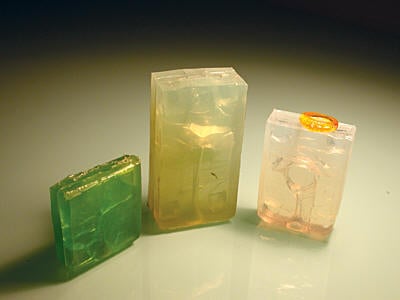Testing the CAD/CAM LMR Mold Compound
The new Romanoff LMR is a clear silicone RTV (room temperature vulcanizing) liquid mold rubber compound with a platinum-containing catalyst, which makes it ideal for use by jewelry manufacturers. Curing can be heat-accelerated, but the compound does not require heat to cure, so it is ideal for delicate wax models and intricate resin patterns produced by rapid prototype (RP) systems.
3 Minute Read
The new Romanoff LMR is a clear silicone RTV (room temperature vulcanizing) liquid mold rubber compound with a platinum-containing catalyst, which makes it ideal for use by jewelry manufacturers. Curing can be heat-accelerated, but the compound does not require heat to cure, so it's ideal for delicate wax models and intricate resin patterns produced by rapid prototype (RP) systems.
Overall, I found the LMR similar to several other RTV mold compounds that I have worked with. The following are specific points about my experience with this new product.
Instructions for Use
Although I had success working with the LMR rubber, I did not receive thorough instructions for mixing. The instructions on the containers indicate that you should stir the base and shake the catalyst before mixing, and use a ratio of 10 parts catalyst to 100 parts base. The critical piece of missing information for me was how much product I needed to mix to make a mold. I used the following formula to calculate the volume of my RTV mold frame:
- Mold frame ID in inches (width x thickness x height required to cover your model) = Volume in cubic inches
- Volume in cubic inches x 20.28 = Grams of Base and Catalyst required to fill the calculated volume
- If the total of Base and Catalyst is "Y," Y/11×10=Base
- Y - Base = Catalyst
This formula is critical if you make your own mold frames, which vary in size and therefore require different amounts of material per job. I make my own RTV mold frames from aluminum bar stock and Plexiglas sheet that I buy from Lowe's. These frames are much taller than many that I see in catalogs because I don't like to tape the top to keep the RTV from spilling over when I vacuum the mix.
Clean Conditions Required
The LMR compound must be processed under clean conditions, as curing can be affected by contaminants such as solvents and some glues, including super glue. In addition, sulfur compounds that you might find in natural rubber products will adversely affect the outcome of the mold. This is not to suggest that you use the same molds for different mold materialsâ"which you should never doâ"but let's say you want to reuse sprues or sprue formers. Clean them with acetone or heat them with a torch to burn off the sulfur compounds. If you are gluing on a sprue, as I do for RP molds, allow the glue to cure completely before pouring in the RTV compound. If you are making the mold overnight, it's a good idea to use sticky wax to attach the sprue.
Properties of mold material
The LMR is very clear when the mold is finished. This is especially helpful for working with RP patterns and carved wax models, when you want to see exactly what you are cutting. The LMR eliminates guesswork and enables you to make parting lines exactly where you want them.
Like other RTV compounds, the LMR rubber is fairly strong (Shore hardness = 20 durometers) and does not stick to RP models. It is also true to its promise of being a "no-shrink" compound.
Speed of Mold Making
I made two LMR molds using two different methods. The first mold, which I made under room temperature conditions, cured overnight for 16 hours before I cut it. It may take 24 hours to fully cure, but it can be cut after 16 hours. I made the second by submersing the filled mold frame in a crock pot of 180°F/82°C water. This elevated temperature cured the second mold to my satisfaction in about two hours. It was probably finished in a little over an hour.
Supplier's Note
In regard to the instructions provided with LMR, we do not include suggested amounts because mold sizes vary. If you have any questions about using LMR, please contact us at 1-631-842-2400 or visit Romanoff.com.
J. Tyler Teague is the owner of JETT Research, a jewelry manufacturing consulting firm in Johnson City , Tennessee.
The award-winning Journal is published monthly by MJSA, the trade association for professional jewelry makers, designers, and related suppliers. It offers design ideas, fabrication and production techniques, bench tips, business and marketing insights, and trend and technology updates—the information crucial for business success. “More than other publications, MJSA Journal is oriented toward people like me: those trying to earn a living by designing and making jewelry,” says Jim Binnion of James Binnion Metal Arts.
Click here to read our latest articles
Click here to get a FREE four-month trial subscription.
You assume all responsibility and risk for the use of the safety resources available on or through this web page. The International Gem Society LLC does not assume any liability for the materials, information and opinions provided on, or available through, this web page. No advice or information provided by this website shall create any warranty. Reliance on such advice, information or the content of this web page is solely at your own risk, including without limitation any safety guidelines, resources or precautions, or any other information related to safety that may be available on or through this web page. The International Gem Society LLC disclaims any liability for injury, death or damages resulting from the use thereof.
The All-In-One Jewelry Making Solution At Your Fingertips
When you join the Ganoksin community, you get the tools you need to take your work to the next level.
Trusted Jewelry Making Information & Techniques
Sign up to receive the latest articles, techniques, and inspirations with our free newsletter.
